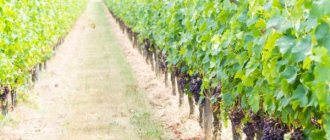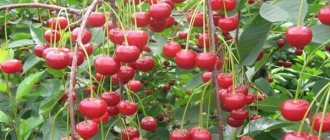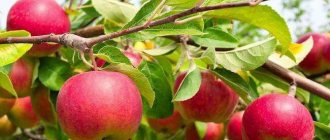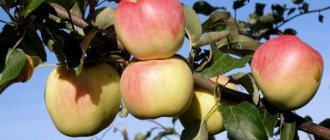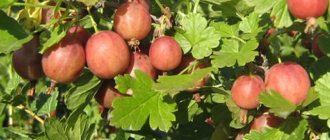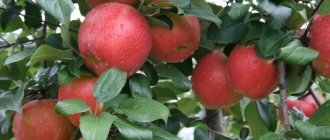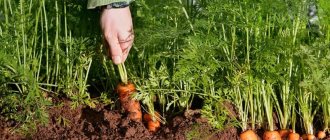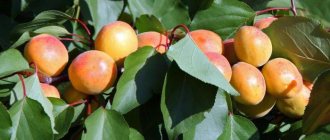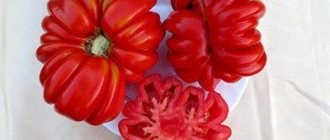Until the 90s of the last century, our market did not pamper customers with apple varieties.
It was almost impossible to choose. So they just bought apples. Our domestic ones.
one of the first non-our varieties to be remembered.
Now you can choose on the market. And very often you choose this variety of apples.
The Gala apple tree variety surprises not only with its name:
- The rapid spread across many regions of the world is impressive .
Golden Delicious. And in conservative England, this variety has been planted over large areas for industrial cultivation.
It even competed with one of its parents – the Golden Delicious variety. Not by taste - but by planting area. And the volumes of industrial cultivation.
- Constant updating of varieties and the emergence of new clones.
- The appearance of this variety in areas that do not seem to be entirely suitable for climatic conditions. Even with harsh winters.
- Popular with industrialists and salespeople. Not so for gardeners.
Apple tree Gala
To appreciate someone’s merits, there is a stock phrase: “He went through a difficult and difficult path.” So it is with the Gala apple variety. From New Zealand he came to our region . And relatively quickly.
Judge for yourself:
- Breeder J.H. Kidd bred it in 1957. Other sources call 1962.
- The parents are very famous - Kids Orange Red and Golden Delicious.
A type of Gala apple known from childhood.
Only it is not named after the Greek or Slavic woman Gali. Gala - Malus domestica Gala (from French gala - celebration, celebration ).
And when you look at the apples of this variety and eat them, you understand why it was called that.
Advice! Just don’t compare it with Sumerian-Akkadian mythology - evil demons of the underworld.
Everyone liked the variety.
Industrial plantings in:
- America,
- Brazil,
- Europe.
But not so beautiful and attractive. And, as they say, at the request of the audience (or more correctly, taking into account the demands of the market), they began to create a whole galaxy of new Gala varieties. But with significant coloring. And the result is more than 20 new varieties .
Here are just the most desirable ones:
- Gala Mast.
- Red Gala.
- Royal Gala.
- Red Royal Gala.
- Gala Galaxy.
- Spur Red Gala.
- El Niño.
The fruits are round with a cone.
Barely visible ribs. Don't worry about names. There are great experts who are trying to translate individual names into Russian and even list them at the same time (like the same Royal Gala and Royal Gala, or Ultrared Gala and Extremely Red Gala).
Now about the apple tree itself:
- A tree of average height does not attract much attention. A lot of those.
- The branches droop rather than tend upward.
- Dark green, egg-shaped leaves. With a clearly visible tip.
- White, saucer-shaped flowers . Not large.
- It bears fruit both on ringlets and on spears and twigs.
- Fruit. Skeptics call average 130-140 g. There are also larger ones - up to 170 g. Round with a cone. Barely visible ribs.
- Coloring. You will see an orange-red blush against a greenish-yellow background. Indistinct.
- The taste is more unanimous - very tasty: the flesh is dense, light yellow and sweet and sour. The dessert taste will provide the widest range of their use: from juices to jams. And just eat it fresh. Even in dietary nutrition.
Gala Mast
- The most popular early winter mutant of the Gala variety.
- The largest of the Gala varieties.
Not superfluous:
- At the word mutant, some people shudder convulsively. Watch enough horror films...
- Mutation ( Latin mutatio - change) is a persistent... transformation of the genotype that occurred under the influence of the external or internal environment. Note that change is not always for the better.
- Ozhegov’s explanatory dictionary makes it clear that this is a type of organism that arose as a result of mutation. I myself prefer not a mutant, but a clone.
And this is not the only name. You can meet and eat other varieties without realizing that this is Gala Mast:
- Regal Gala.
- Regal Prince Gala.
- Regal Queen.
All Gala varieties have a lot in common - from growing conditions to storage.
Gala-Mast is the most popular early winter mutant of the Gala variety.
If you compare with its predecessor:
- The fruits are round-conical and larger. 170-180 g is not uncommon.
- The light yellow flesh is juicy and crisp.
- It is very good as a pollinator for other apple trees.
- You will be picking apples at the end of September. Even at the beginning of October.
Important! Well kept.
Even in February you will be able to eat yourself and treat your friends.
Botanical description
According to the description, the Gala apple tree is a low tree with a wide oval-shaped crown and dense spreading branches. Fruiting occurs on both old and annual shoots. The variety is partially pollinated. To increase productivity, it is planted together with Elstar or James Grieve apple trees. The flowering period occurs in the mid-late period.
The fruits are the same size, round in shape with slight ribbing at the top. According to the description of the variety, the Gala apple is yellow or light green in color; the skin may have a slight blurred blush of a reddish-orange hue. The skin is thin, dense, dry.
The pulp is dense, crispy, granular, light yellow in color, and has a pleasant caramel-nut aroma.
The fruits reach technical ripeness in late summer - early autumn, depending on climatic conditions. Gala apples have good transportability and a long shelf life, which can last up to two months. The fruits retain their quality and appearance.
Trees begin to bear fruit regularly 6-7 years after planting. The yield from one tree can reach 80 kg. Over time, the yield decreases, so the number of flowers should be adjusted.
The Gala variety tolerates winter frosts well. The plant is resistant to the development of most diseases and damage from insect pests.
Gala apples grow in temperate climates because they have low frost resistance. Large harvests of apples are harvested in Poland, Russia, Ukraine, Italy and France.
It is used for industrial cultivation. The fruits are consumed fresh, as well as for drying and preparing juices, compotes, baby food, and jams .
additional characteristics
Peculiarities
And why such fame and popularity:
Apple variety Gala Shniga.
- Productivity is high . It is not for nothing that it is included in the top ten varieties from New Zealand to the Moscow region.
- Begins to bear fruit early.
- There are no problems with transportation and keeping quality of fruits.
What complaints do gardeners and specialists have:
- Many people want larger fruits . There are always enough skeptics.
- And winter hardiness is higher . To expand the cultivation areas of this variety. And gardeners with a not very favorable climate should have this variety in their garden.
- The vigorous growth of young trees slows down when they begin to bear fruit.
Advice! Adjust the ovary. And do not allow the crop to be overloaded:
- And the apples are getting smaller.
- And it may be the reason for the occurrence of periodicity of fruiting. The harvest will not be annual.
Favorable areas for cultivation
There are enough of them:
- If we take into account their industrial cultivation in Europe and America. And in China.
- But the best for them are the forest-steppe and steppe zones . Both soil and humidity are suitable. Poland, Ukraine, Russia.
- He also masters the subtropics.
Tree height
- Already at an advanced age it can even reach 5 meters .
- The variety itself .
- It is also sometimes called vigorous.
- Consider the rootstocks. On a semi-dwarf tree, even an adult tree does not exceed 3.5 m.
Crown width
- The crown is like a flattened ball, unevenly spreading.
- They also compare it with a wide-pyramidal one.
- And its width corresponds to the selected rootstock.
Productivity
- Some are impressed - 50-80 kg per tree . Even 90 kg.
- And for some, 15 is enough.
- And you can regulate it (both the flowers and the ovary). If you want bigger apples. After all, the variety has a certain tendency to overload.
- Fruits annually.
- Older apple trees may exhibit periodicity and reduced yield.
Tasting assessment
When mentioning the most delicious varieties of apples, you should definitely include the Gala variety in the list.
Over 4.5 out of five. They also give 4.6-4.7.
And be sure to pay attention to :
- Freshness,
- Hardness,
- Sweetness.
And a little information about the deliciousness and health benefits of Gala apples:
- Vitamin A - for clear eyes.
- Ascorbic acid will boost your immunity.
- Everyone needs iron
- One of the main varieties for dietary nutrition.
Winter hardiness
28-30 degrees below zero is not a problem for most apple trees of this variety. But short-term!
Disease resistance
Who is not sick at all? There is no such. But everything is different. What hardening and stability.
So it is with the Gala varieties:
- Resistance to scab is somewhere average.
- To powdery mildew and European cancer – high.
- There are bacterial cancer lesions.
Help trees resist disease with a set of disease prevention measures .
Lifespan of a tree
How many apples will please you depends on the selected rootstock .
And they don’t pay special attention to this. But there are no 100-year-old apple trees yet. Because of his young age.
Rules for planting seedlings
The planting site should be chosen with a low level of moisture, that is, away from bodies of water. It is recommended to have other varieties of apple trees near the location of the Gala tree. However, it is not at all necessary that they belong to varieties of this variety. Other apple tree representatives will act as pollinators, which will improve the quality and yield of the gala.
Planting seedlings
Other planting recommendations:
- planting time - no later than 30 days before the first frost;
- preparation of the planting hole - a full month before the day of planting the seedling;
- size - up to 1 meter deep, 1 meter wide;
- planting mixture - a layer of fertile soil collected during the preparation of the hole, mixed with organic fertilizers, a little ash and lime are added
Productivity
For a high-quality harvest, it is necessary to keep the number of inflorescences under control. If there are too many of them, which happens with the age of the tree, the fruits are very large, but small in size. To improve quality, it is necessary to slightly thin out the apple ovaries every year and reduce the number and density of inflorescences. This way you can maintain the quality of the harvest.
Thinning apple ovaries
Not too strong, the plant does not tolerate excess moisture. The initial frequency for young seedlings is once a week. Further, as they grow older, it is necessary to reduce watering, carrying them out only when the upper layers of the soil are very dry.
Pest prevention
Young plants are usually covered with a chalk solution at the bottom of the post. After the five-year mark, a lime mixture is used. Also, at the beginning of spring, the crown is treated with a 3% concentration of Brodsky liquid from a spray bottle, and during the appearance of buds and after the inflorescences wither, ½% copper oxychloride is used.
Spraying trees in spring
It is periodically recommended to disinfect the top layers of soil from insect pests. To do this, use bleach and dig up the soil around the tree.
Newly emerging branches are cut to a third of their grown length. This allows you to maintain high-quality yields and save the tree from being overloaded with fruits in the future.
Reviews
Sergey. Excellent variety. I have long dreamed of having it in my garden, as soon as I came across the description and photo. And it already exists and is bearing fruit. This only convinces me of the correctness of the chosen variety - Gala Mast.
The dessert taste is incomparable. But he cannot lie down for long. But for the New Year we have these apples on the table. And not from the store, but our own.
Andrey. How fragrant and juicy Gala apples are. And in vain they say that they do not have a very beautiful appearance. Taste, not appearance, is the most important thing. And absolutely easy to care for. General rules of care, as for all apple trees. And you need to water even less. The harvest needs to be regulated. They don't crumble on their own. But I also do this on other varieties (Idared, Golden Delicious). And the frosts were below 30 degrees. We recovered quickly.
Svetlana. I consider the Gala Mast apple tree to be the pride of my garden. It bears fruit every year and is very decent. Delicious apples suitable for everything: juices, jams, drying. And fresh, even after the New Year. And they look better than the main variety. If you plant it at home, you won’t regret it. Only better on a semi-dwarf. If the terrain allows.
Nikolai. Anyone who doesn’t have at least some Gala variety in their garden (especially clones) has lost a lot. Your own apples are incomparable to those purchased at the market. Fully consistent when you see the photo and description of the variety
Harvest and storage
Gala apple trees are harvested in late September - early October. Apples are picked from the tree - the carrion is not stored for a long time and requires immediate processing. If there is a task to preserve the harvest until spring, then Gala apples are wrapped in paper, tracing paper or ordinary newspaper, and carefully placed in boxes. Place the boxes of apples in a cool, dry place (ideally a cellar) and eat them, taking them out as desired.
During the harvest period, it is important to be prepared and be able to quickly process “substandard” apples. They are boiled with sugar, made into candied fruits, ground into jams and juices. The resulting preparations are delicious, and can then be easily added to any desserts and baked goods.
Features of planting and care
Landing
Planting an apple tree in spring.
Deadlines
It could be:
- And spring - until the end of April.
- And autumn - 25-30 days before the onset of the first frost. I like autumn better.
Technology
- What kind of seedling is the same kind of hole: 60-80 cm in diameter and 50-80 cm deep .
- Prepare it 20-30 days before planting.
- Not a single seedling will be against a well-prepared planting hole with fertile soil. Add fertilizer and organic matter.
Growing
- Like everyone else, I like free placement. But it is not afraid of shade .
- And it can withstand droughts .
- Undemanding to soils.
Important! Does not like close groundwater. And long frosty winters.
Agricultural technology
Watering 4-5 times per season. But be sure to:
- During flowering.
- Before fruit setting.
- 3 weeks before ripening.
- If there is no rain - at least 3 buckets under the apple tree.
The nearby groundwater dictates its own conditions. Please note. This variety does not really like excess moisture.
Pruning and crown formation
The formation of the crown of an apple tree in the form of pruning is required for fruit plantings almost throughout the entire life of the plant.
The goals are optimal forms for ripening large fruits and resisting diseases.
In the second year , you begin to form a crown. And which one - the choice is yours! There are enough options.
Most optimal for a medium-sized tree (like Gala):
- Whorled-tiered.
- Sparsely tiered.
- Fusiform.
- Cup-shaped.
- There are also palmettes and cordons.
Pollinator varieties
The variety itself is partially self-pollinating . But with others he is perfect.
This:
- Idared.
- Gloucester.
- Elstar.
- Eliza.
- Delbarestivale.
- Red Delicious.
- Melrose.
- Discovery.
And many more.
Apple tree diseases and pests
Gala apple trees, like other plants, are susceptible to dozens of dangerous ailments. They are harmed by rain, drought, hares that gnaw bark in winter, and small gray caterpillars. Gala apple trees at a young age, like children, require an eye and an eye. Early diagnosis and treatment can stop the disease and prevent the death of the plant.
Pests
Even innocent-looking insects often attack the young Gala apple tree. The bark is eaten by slugs, snails, butterflies, and small gray caterpillars that literally bore holes in the leaves. Since insects love secluded and overgrown (thickened) corners, it is worth providing access to any part of the Gala apple tree. The most effective preventive measure is timely pruning in autumn and spring.
Scab
Scab is considered a fungal disease; it is activated by high humidity: after prolonged rains, fogs, and dampness. Scab is recognized by characteristic spots on apples. At first they are pale, greenish-yellow in color, then they darken and then crack. When the disease is advanced, the trees suffer so much that they wither and die before our eyes. Agriculturalists consider the only preventive measures to be early detection of the disease, proper care and pruning, and, of course, moderate watering.
Gala apple trees are considered resistant to scab, but if they are not properly cared for, they too will get sick. Be careful.
European apple canker
European cancer is also fungal in nature. Its main danger is that it hides safely in the bark, overwinters on the Gala apple tree, and then wakes up and begins to cause harm. The damage appears as cankers on the tree crown in regular circle shapes. As soon as you notice a strange crack or bald spot, start treating the apple tree, otherwise the cancer will creep further, gradually taking over the entire plant. It is best to remove branches affected by cancer. And small wounds on the apple tree are covered with copper sulfate, potassium permanganate and brilliant green.
Features of ripening and fruiting
Beginning of fruiting
- 5-6th year, or even 7th year on a tall seedling rootstock.
- 3-4 years on dwarf.
Flowering period
Doesn't bloom early . Flowering is considered medium and even medium late. But how it blooms! Blooms profusely. There are a lot of ovaries - thin them out - out of 2-3, leave 1-2.
Gala blooms profusely.
Deadlines
Fruit ripening
Do not wait for the fruits on the apple tree to reach consumer ripeness . It's one thing to remove fruit for storage. Most likely, you will refrain from using them. This is the end of September and the beginning of October.
And a separate issue is their consumer status. In November they are already on your table . And delicious.
Attention! Apples stick well to the branches. They don't fall much.
Fruit storage
Again - how to store:
- in an ordinary basement or cellar for more than 3 months.
- Under good and special conditions and six months.
Disease Prevention
Apple trees are susceptible to powdery mildew, European cancer, scab, and moniliosis. To prevent diseases, plants should be sprayed with fungicidal agents. This measure will also help destroy insect pests that may periodically appear on fruit trees.
To prevent the development of diseases, trees should be treated with a solution of quicklime or chalk. To treat the crown, you can use copper sulfate or Bordeaux mixture. This treatment is carried out 2-3 weeks before the onset of the flowering period. Lime can be used to treat the upper layers of soil in the tree trunk circle; digging up the soil in the autumn will also help control pests.
Subspecies and options
Gala
Royal
Or Royal Gala. And also Tenroy or Ten Hove Gala, named after the gardener who first discovered it. But here they would say that they grew it long and hard...
The shape is the same as Gala Mast. The color is more red . It is he who is considered to be the first clone of Gala. And someone calls him a mutant.
Gala Galaxy
And it looks like Gala Mast:
- Just a solid dark red coating and with the same dark touches.
- Ripens a little earlier.
- 160-180 g can be stored for up to 5 months.
- And the pollinators are the same.
- Yellow-cream juicy sweet and sour pulp.
Apple tree Galaxy.
Delicious
Exists in the imagination. Maybe this is in the future. Delicious is present only when crossed.
Gala Brookfield
Ripening - early September.
If you create ideal conditions, you will eat all winter. If you grow a good harvest!
Variety Brookfield.
Mondial
Quite famous (since 1978) and popular. Gardener D. Mitchell was walking and suddenly saw a Gala apple. But not quite Gala. And he named it Mondial Gala (Mitchgla, Imperial Gala).
More elongated in shape . And the coloring is a little different.
Cube
Clone of the Gala variety - Cube.
This clone is the result of the activities of Krasnodar breeders . Since 2007, it has been included in the State Register for the North Caucasus region.
Light yellow fruits (150-180 g). Red-orange blush almost all over the apple. The dessert taste is even given 4.8 points.
Prince
One of the names of the Gala Mast variety.
Red
Variety Gala Red.
The name speaks for itself. Red – red :
- Ripening is the end of August (third decade) and can be stored almost until March 8th.
- Already in the 2nd year the first apples will appear
- Average resistance to drought, scab, and even weaker to powdery mildew and frost.
- Businessmen have special respect - transportability and storage with taste and size (160-190g) guarantee the demand for this variety. And whoever offers smaller ones weighing (110-140 g) will sell them longer.
Costa
I have not yet come across this variety. I can recommend Jonagold Decosta.
Gala Natalie
Variety Gala Natali.
Like all Gala apples, it has everything - both taste and appearance. But the apples are smaller.
On dwarf rootstock M9
Their height is only one third the height of trees whose rootstock is an Antonovka seedling.
On semi-dwarf 54-118 and M26
Half lower with Antonovka rootstock. They bear fruit after 2-3 years
Columnar
Attracts attention. But the rows of Gala apple trees on a dwarf rootstock are no less impressive.
Important! Those who are interested in container gardens will find Spur Red Gala a godsend for them. Both the fruiting is slow and the growth is weak (less by almost a third).
Growing new clones continues. Still to meet:
- Gala Rouge.
- Scarlet Gala.
- Galagored.
Growing in regions
The Gala apple tree is moderately resistant to frost.
In central Russia, it is precisely the average resistance to frost that allows the cultivation of Gala varieties.
But look at the offers from garden nurseries in the Moscow region and Leningrad region. This means that gardeners grow it. Apples are delicious to eat.
In Ukraine. Since the seventies, it has been zoned throughout Ukraine (more precisely, since 1993) in the steppe zone. And rightfully so.
In the Krasnodar region the variety is zoned. They not only grow it, but also create their own clones (Gala cube).
History of selection of the Gala variety
The variety received the right to a separate existence in New Zealand, and its progenitors were two popular varieties: Godin Delicious and Kids Orange. Today, the selection of Galovsky apples continues successfully and more than two dozen varieties are already known. The rapid spread across all continents was facilitated by the high productivity of the variety: Gala occupies the second position in terms of productivity among other varieties of apple crops.
In European countries and the USA, where Gala apples grow, they are very common. They appeared on Russian territory relatively recently - about 20 years ago. But even in such a short time for the spread of fruit trees, this variety managed to take root well in this part of Europe and demonstrates good productivity.
The country of origin of the Gala variety is New Zealand. The variety was developed in 1957 by crossing the Golden Delicious and Kidd's Orange Red varieties. The author of the variety is J. H. Kidd. After receiving a prototype, having assessed its not very outstanding external characteristics, the author begins to develop new hybrid species in order to improve quality.
With the advent of high-quality hybrids, varieties began to gain popularity in 1965 and are used in industrial-scale plantings in New Zealand and Europe, from where they are brought to Russia and Ukraine. However, in these countries the variety was regionalized only in 1993 and was not used on an industrial scale. By 2021, the variety has become widespread worldwide and is recognized as one of the best.
